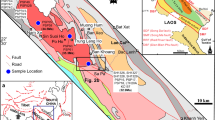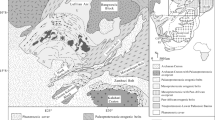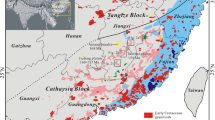Abstract
Granites were shown to be excellent geochronological, structural and geodynamic markers. Among several generations of granites described in the Neoproterozoic of Ethiopia, we studied the post-tectonic Konso pluton to characterise the post-Pan-African evolution of the Mozambique Belt (MB) of southern Ethiopia. The Konso pluton is a composite intrusion of slightly peraluminous and ferro-potassic, bt (biotite)–leucogranites, bt–hbl (hornblende)–granites and subordinate coeval metaluminous monzodiorites, intruded into high-grade gneiss–migmatite associations of the MB. The whole suite displays chemical features of A-type granites. It is LIL- and HFS-elements enriched with Y/Nb and Yb/Ta≥1.2. The granites and leucogranites show non-fractionated to fractionated REE patterns [(La/Yb)N=0.3–9.4] with strong negative Eu anomalies. The monzodiorites show fractionated REE patterns [(La/Yb)N=5.5–7.4] with negligible negative Eu anomaly. The low initial (87Sr/86Sr)450 ratios (0.70113–0.70441) and positive εNd(450) values (+1.8 to +3.3) suggest an isotopically primitive source. The Konso granites are likely to be derived from a basaltic parent, with minor contamination by crustal material with high Y/Nb and low Sr initial isotopic ratios. Age of pluton emplacement is constrained by a Rb–Sr isochron and zircon U–Pb data at 449±2 Ma. The Konso pluton is, therefore, the witness of an Ordovician A-type magmatic event, which marks a change from convergence, related to the Pan-African collision, to extension in the Mozambique Belt of southern Ethiopia.










Similar content being viewed by others
References
Alene M, Barker AJ (1993) Tectonometamorphic evolution of the Moyale region, southern Ethiopia. Precambrian Res 62:271–283
Anderson JL, Smith DR (1995) The effects of temperature and f O2 on the Al-in-hornblende barometer. Am Mineral 80:549–559
Asrat A (1997) Geology and geochemistry of the Negash Pluton and their metallogenic significance, central Tigrai. MSc Thesis, Addis Ababa University, Ethiopia
Asrat A, Barbey P, Gleizes G (2001) The Precambrian geology of Ethiopia: a review. Afr Geosci Rev 8:271–288
Asrat A, Barbey P, Gleizes G, Reisberg L, Ludden J (2002) Structure, géochimie et âge du pluton Negash (nord Ethiopie): implications sur la nature du Bouclier Arabo-Nubien (ANS) et ses relations avec la Chaîne Mozambique (MB). RST-19, 9–12 April, Nantes, Résumés, pp 51–52
Asrat A, Gleizes G, Barbey P, Ayalew D (2003) Magma emplacement and mafic-felsic magma hybridization: structural evidence from the Pan-African Negash pluton, Northern Ethiopia. J Struct Geol 25:1451–1469
Ayalew D, Barbey P, Marty B, Reisberg L, Yirgu G, Pik R (2002) Source, genesis, and timing of giant ignimbrite deposits associated with Ethiopian continental flood basalts. Geochim Cosmochim Acta 66:1429–1448
Ayalew T, Gichile S (1990) Preliminary U–Pb ages from southern Ethiopia. In: Rocci G, Descamps M (eds) Recent data in African earth sciences. CIFEG Occasional Publ 1990/22:127–130
Ayalew T, Bell K, Moore JM, Parrish RR (1990) U–Pb and Rb–Sr geochronology of the western Ethiopian Shield. Geol Soc Am Bull 102:1309–1316
Barbarin B (1999) A review of the relationships between granitoid types, their origins and their geodynamic environments. Lithos 46:605–626
Boher M, Abouchami W, Michard A, Albarède F, Arndt NT (1992) Crustal growth in West Africa at 2.1 Ga. J Geophys Res 97:345–369
Bonavia FF, Chorowicz J (1993) Neoproterozoic structures in the Mozambique orogenic belt of southern Ethiopia. Precambrian Res 62:307–322
Bouchez JL, Hutton DHW, Stephens WE (eds) (1997) Granite: from segregation of melt to emplacement fabrics. Kluwer, Dordrecht
Brueckner HK, Elhaddad MA, Hamelin B, Hemming S, Kröner A, Reisberg L, Seyler M (1995) A Pan-African origin and uplift for the gneisses and peridotites of Zabargad Island, Red Sea: A Nd, Sr, Pb, and Os isotope study. J Geophys Res 100:22283–22297
Clemens JD, Holloway JR, White AJR (1986) Origin of an A-type granite: experimental constraints. Am Mineral 71:317–324
Collins WJ, Beams SD, White AGR, Chappell BW (1982) Nature and origin of A-type granites with particular reference to southeastern Australia. Contrib Mineral Petrol 80:189–200
Creaser RA, White AJR (1991) Yardea dacite-large-volume, high-temperature felsic volcanism from the Middle Proterozoic of South Australia. Geology 19:48–51
Creaser RA, Price RC, Wormald RJ (1991) A-type granites revisited: assessment of a residual-source model. Geology 19:163–166
Davidson A (1983) The Omo River project: reconnaissance geology and geochemistry of parts of Illubabor, Keffa, Gemu Gofa and Sidamo, Ethiopia. Ethiopian Institute of Geological Surveys
Deloule E, Alexandrov P, Cheilletz A, Laumonier B, Barbey P (2002) Zircon U–Pb ion-probe dating of the orthogneisses from the Canigou–Carança massif (eastern Pyrenées, France): irrelevance of the Cadomian basement/Paleozoic cover model. Int J Earth Sci 91:398–405
DePaolo DJ (1988) Neodymium isotope geochemistry, an introduction. Springer, Berlin, Heidelberg New York
de Wit MJ, Chewaka S (1981) Plate tectonic evolution of Ethiopia and the origin of its mineral deposits: an overview. In: Chewaka S, de Wit MJ (eds) Plate tectonics and metallogenesis: some guidelines to Ethiopian mineral deposits. Ethiopian Inst Geol Surv Bull 2:115–129
Eby GN (1990) The A-type granitoids: a review of their occurrence and chemical characteristics and speculations on their petrogenesis. Lithos 26:115–134
Eby GN (1992) Chemical subdivision of the A-type granitoids: petrogenetic and tectonic implications. Geology 20:641–644
Ewart A, Griffin WL (1994) Application of proton-microprobe data to trace-element partitioning in volcanic rocks. Chem Geol 117:251–284
Ferré EC, Caby R, Djouadi MT, Bouchez JL (1998) Pan-African, post-collisional, ferro-potassic granite and quartz–monzonite plutons of eastern Nigeria. Lithos 45:255–280
Frost BR, Barnes CB, Collins WJ, Arculus RJ, Ellis DJ, Frost CD (2001) A geochemical classification for granitic rocks. J Petrol 42:2033–2048
Gichile S (1992) Granulites in the Precambrian basement of southern Ethiopia: geochemistry, P–T conditions of metamorphism and tectonic setting. J Afr Earth Sci 15:251–263
Harris NBM (1996) Radiogenic isotopes and the interpretation of granitic rocks. Episodes 19:107–113
Harrison TM, Watson EB (1984) The behaviour of apatite during crustal anatexis: equilibrium and kinetic considerations. Geochim Cosmochim Acta 48:1467–1477
Heltz RT (1976) Phase relations of basalts in their melting ranges at PH2O=5 kbar. II. Melt compositions. J Petrol 17:139–193
Henderson P (1982) Inorganic geochemistry. Pergamon, Oxford
Höhndorf A, Meinhold KD, Vail JR (1994) Geochronology of anorogenic igneous complexes in the Sudan: isotopic investigations in north Kordofan, the Nubian Desert and the Red Sea Hills. J Afr Earth Sci 19:3–15
Kazmin V, Shiferaw A, Balcha T (1978) The Ethiopian Basement and possible manner of evolution. Geol Rundsch 67:531–546
Key RM, Charsley TJ., Hackman BD, Wilkinson AF, Rundle CC (1989) Superimposed Upper Proterozoic collision-controlled orogenies in the Mozambique Orogenic Belt of Kenya. Precambrian Res 44:197–225
Kröner A, Linnebacher P, Stern RJ, Reischmann T, Manton W, Hussein IM (1991) Evolution of Pan-African assemblages in the southern Red Sea Hills, Sudan, and in southwestern Arabia as exemplified by geochemistry and geochronology. Precambrian Res 53:99–118
Küster D (1993) Geochemistry and petrogenesis of Permo-Jurassic oversaturated alkaline complexes of northern Kordofan, central Sudan. In: Thorweihe U, Scheandelmeier H (eds) Geoscientific research in NE Africa, Rotterdam, pp 197–201
Küster D, Harms U (1998) Post-collisional potassic granitoids from the southern and northwestern parts of the Late Neoproterozoic East African Orogen: a review. Lithos 45:177–196
Küster D, Utke A, Leupolt L, Lenoir JL, Haider A (1990) Pan-African granitoid magmatism in northeastern and southern Somalia. Berliner Geowiss Abh A 120:519–536
Lenoir JL, Küster D, Liégeois J-P, Utke A, Haider A, Matheis G (1994) Origin and regional significance of late Precambrian and early Paleozoic granitoids in the Pan-African belt of Somalia. Geol Rundsch 83:624–641
Ludwig KR (1991) Isoplot, a plotting and regression program for radiogenic isotope data. US Geophys Soc Openfile Report 91-445
McGuire A, Stern RJ (1993) Granulite xenoliths from western Saudi Arabia: the lower crust of the late Precambrian Arabian–Nubian Shield. Contrib Mineral Petrol 114:395–408
Michard A, Gurriet P, Soudant M, Albarède F (1985) Nd isotopes in French Phanerozoic shales: external vs internal aspects of crustal evolution. Geochim Cosmochim Acta 49:601–610
Mock C, Arnaud NO, Cantagrel JM, Yirgu G (1999) 40Ar/39Ar thermochronology of the Ethiopian and Yemeni basements: reheating related to the Afar plume? Tectonophysics 314:351–372
Nakamura N (1974) Determination of REE, Ba, Fe, Mg, Na and K in carbonaceous and ordinary chondrites. Geochim Cosmochim Acta 38:757–775
Nédélec A, Stephens WE, Fallick AE (1995) The Pan-African stratoid granites of Madagascar: alkaline magmatism in a post-collisional extensional setting. J Petrol 36:1367–1391
Nédélec A, Madison Razanatseheno M, Rakotondrazafy M, Ralison B (2002) Le magmatisme potassique tardi-pan-africain de Madagascar. RST-19, 9–12 April, Nantes, Résumés
Otten MT (1984) The origin of brown hornblende in the Artfjället gabbro and dolerites. Contrib Mineral Petrol 86:189–199
Paquette JL, Nédélec A (1998) A new insight into Pan-African tectonics in the east–west Gondwana collision zone by U–Pb zircon dating of granites from Central Madagascar. Earth Planet Sci Lett 155:45–56
Pearce JA, Harris NBM, Toille AG (1984) Trace element discrimination diagrams for the tectonic interpretation of granitic rocks. J Petrol 25:956–983
Peccerillo A, Taylor SR (1976) Geochemistry of Eocene calc-alkaline volcanic rocks from the Kastamonu area, northern Turkey. Contrib Mineral Petrol 58:63–81
Pik R, Deniel C, Coulon C, Yirgu G, Hofmann C, Ayalew D (1998) The northwestern Ethiopian plateau flood basalts: classification and spatial distribution of magma types. J Volcanol Geotherm Res 81:91–111
Pouchou JL, Pichoir F (1991) Quantitative analysis of homogeneous or stratified microvolumes applying the model ‘PAP’. In: Heinrich KFJ, Newbury DE (eds) Electron probe quantitation. Plenum, New York, pp 31–75
Rapp RP, Watson EB (1995) Dehydration melting of metabasalt at 8–32 kbar: implication for continental growth and crust–mantle recycling. J Petrol 36:891-932
Shackleton RM (1979) Precambrian tectonics of northeast Africa. In: Al Shanti AMS (ed) Evolution and mineralization of the Arabian–Nubian Shield, vol 2. Pergamon, Oxford, pp 1–6
Spear FS (1981) An experimental study of hornblende stability and compositional variability in amphibolite. Am J Sci 281:697–734
Stern RJ, Abdelsalam MG (1998) Formation of juvenile continental crust in the Arabian–Nubian shield: evidence from granitic rocks of the Nakasib suture, NE Sudan. Geol Rundsch 87:150–160
Stern RJ, Dawoud AS (1991) Late Precambrian (740 Ma) charnockite, enderbite, and granite from Jebel Moya, Sudan: a link between the Mozambique Belt and the Arabian–Nubian Shield? Geology 99:648–659
Sun SS, McDonough WF (1989) Chemical and isotopic systematics of oceanic basalts: implications for mantle composition and processes. In: Saunders AD, Norry MJ (eds) Magmatism in the ocean basins. Geol Soc Spec Publ 42:313–345
Tadesse T, Hoshino M, Sawada Y (1999) Geochemistry of low-grade metavolcanic rocks from the Pan-African of the Axum Area, northern Ethiopia. Precambrian Res 99:101–124
Tadesse T, Hoshino M, Suzuki K, Iizumi S (2000) Sm–Nd, Rb–Sr and Th–U–Pb zircon ages of syn- and post- tectonic granitoids from the Axum area of northern Ethiopia. J Afr Earth Sci 30:313–327
Teklay M, Kröner A, Mezger K, Oberhansli R (1998) Geochemistry, Pb–Pb single Zircon ages and Nd–Sr isotope composition of Precambrian rocks from southern and Eastern Ethiopia: implications for crustal evolution in East Africa. J Afr Earth Sci 26:207–227
Vail JR (1976) Outline of the geochronology and tectonic units of the basement complex of northeast Africa. Proc R Soc Lond 350A:127–141
Vail JR (1985) Alkaline ring complexes in Sudan. In: Black R, Bowden P (eds) Alkaline ring complexes in Africa. J Afr Earth Sci 3:51–59
Vail JR (1989) Ring complexes and related rocks in Africa. J Afr Earth Sci 8:19–40
Watson EB, Harrison TM (1983) Zircon saturation revisited: temperature and compositional effects in a variety of crustal magma types. Earth Planet Sci Lett 64:295–304
Whalen JB, Currie KL, Chappell BW (1987) A-type granites: geochemical characteristics, discrimination and petrogenesis. Contrib Mineral Petrol 95:407–419
White AJR, Chappell BW (1983) Granitoid types and their distribution in the Lachlan Fold Belt, South Western Australia. Geol Soc Am Mem 159:21–34
Wiebe RA (1996) Mafic-silicic layered intrusions: the role of basaltic injections on magmatic processes and the evolution of silicic magma chambers. Trans R Soc Edinb Earth Sci 87:233–242
Woldehaimanot B, Behrmann JH (1995) A study of metabasite and metagranite chemistry in the Adola region (South Ethiopia): implications for the evolution of the East African Orogen. J Afr Earth Sci 21:459–476
Worku H, Schandelmeier H (1996) Tectonic evolution of the Neoproterozoic Adola Belt of southern Ethiopia: evidence for a Wilson Cycle process and implications for oblique plate collision. Precambrian Res 77:179–210
Acknowledgements
We are grateful to C. Spatz, D. Mangin and M. Champenois for technical assistance. Our sincere gratitude goes to T. Nardos and D. Hailu for their invaluable assistance during the field work. The two anonymous referees are thanked for their valuable comments that contributed to improve the manuscript. We are indebted to the Department of Geology and Geophysics, Addis Ababa University, for the logistical support during the field work. This work was supported by a research grant from the French Ministry of Foreign Affairs and financial support from INSU-Ethiopie-2000 Project.
Author information
Authors and Affiliations
Corresponding author
Appendix
Appendix
Analytical methods
Mineral compositions were analysed with a CAMECA SX-50 Electron Microprobe at the University Henri Poincaré (Nancy). Operating conditions were 20-nA sample current, 15-kV accelerating potential, counting times of 20 s and a beam diameter of 1 µm. Calibration was made on a combination of silicates and oxides. Data reductions were performed using the PAP correction procedure (Pouchou and Pichoir 1991).
Whole-rock major and trace elements were analysed by ICP-AES and ICP-MS at CRPG-CNRS (Nancy). Analytical uncertainties are given as 2% for major elements, and as 5 or 10% for trace element (except REE) concentrations higher or lower than 20 ppm, respectively. Precision for REE is estimated at 5% when chondrite-normalised concentrations are >10 ppm and at 10% when they are lower.
Separation of Rb–Sr and Sm–Nd was made according to the methods of Michard et al. (1985) and Boher et al. (1992). Rb, Sr, Sm and Nd concentrations were determined using the isotope dilution method. Rb was analysed by thermal ionisation on a Cameca TSN 206 SA mass spectrometer, whereas Sr and Nd isotopic ratios and Sm concentration were measured using a Finnigan MAT 262 mass spectrometer. Measured 87Sr/86Sr and 143Nd/144Nd ratios were normalised to 86Sr/88Sr=0.1194 and 146Nd/144Nd=0.7219, respectively. Repeated analyses of standards NBS 987 for Sr and JM for Nd gave average ratios of 87Sr/86Sr=0.710205±23 (2σ) and 143Nd/144Nd=0.511095±16 (2σ). The blanks for Sr and Nd were negligible (<2 ng for Sr and 0.4 ng for Nd) compared with the extracted quantities from samples. Analytical errors on isotopic ratios (error in the last two digits of the Sr and Nd isotopic ratios) are expressed as 2σ (=two standard errors of the mean).
Rights and permissions
About this article
Cite this article
Asrat, A., Barbey, P. Petrology, geochronology and Sr–Nd isotopic geochemistry of the Konso pluton, south-western Ethiopia: implications for transition from convergence to extension in the Mozambique Belt. Int J Earth Sci (Geol Rundsch) 92, 873–890 (2003). https://doi.org/10.1007/s00531-003-0360-9
Received:
Accepted:
Published:
Issue Date:
DOI: https://doi.org/10.1007/s00531-003-0360-9




